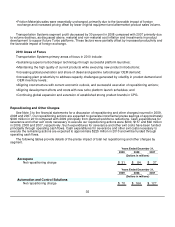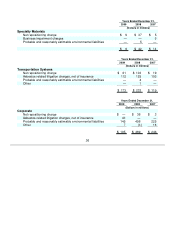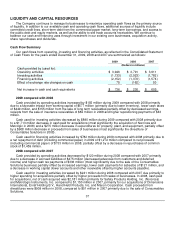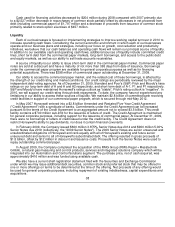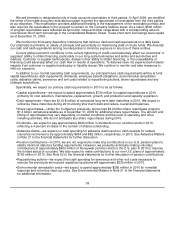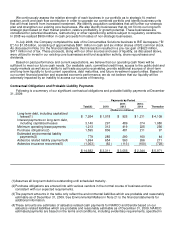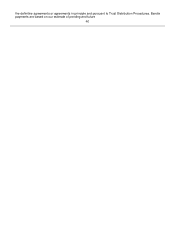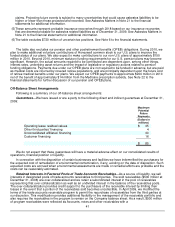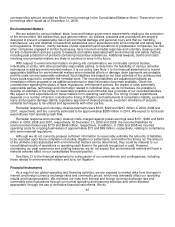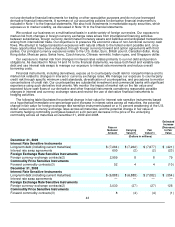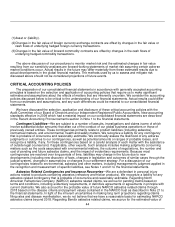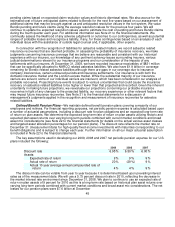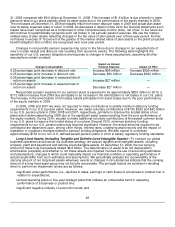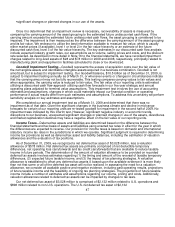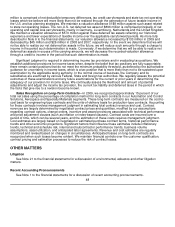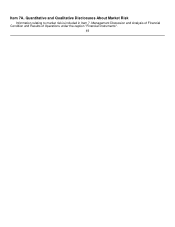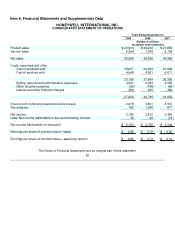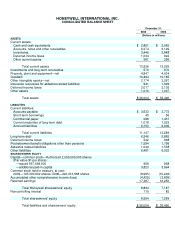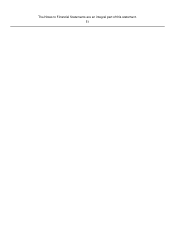Honeywell 2009 Annual Report Download - page 62
Download and view the complete annual report
Please find page 62 of the 2009 Honeywell annual report below. You can navigate through the pages in the report by either clicking on the pages listed below, or by using the keyword search tool below to find specific information within the annual report.
not use derivative financial instruments for trading or other speculative purposes and do not use leveraged
derivative financial instruments. A summary of our accounting policies for derivative financial instruments is
included in Note 1 to the financial statements. We also hold investments in marketable equity securities, which
exposes us to market volatility, as discussed in Note 16 to the financial statements.
We conduct our business on a multinational basis in a wide variety of foreign currencies. Our exposure to
market risk from changes in foreign currency exchange rates arises from international financing activities
between subsidiaries, foreign currency denominated monetary assets and liabilities and anticipated transactions
arising from international trade. Our objective is to preserve the economic value of non-functional currency cash
flows. We attempt to hedge transaction exposures with natural offsets to the fullest extent possible and, once
these opportunities have been exhausted, through foreign currency forward and option agreements with third
parties. Our principal currency exposures relate to the U.S. dollar, Euro, British pound, Canadian dollar, Hong
Kong dollar, Mexican peso, Swiss franc, Czech koruna, Chinese renminbi, Indian rupee, and Singapore dollar.
Our exposure to market risk from changes in interest rates relates primarily to our net debt and pension
obligations. As described in Notes 14 and 16 to the financial statements, we issue both fixed and variable rate
debt and use interest rate swaps to manage our exposure to interest rate movements and reduce overall
borrowing costs.
Financial instruments, including derivatives, expose us to counterparty credit risk for nonperformance and to
market risk related to changes in interest or currency exchange rates. We manage our exposure to counterparty
credit risk through specific minimum credit standards, diversification of counterparties, and procedures to monitor
concentrations of credit risk. Our counterparties are substantial investment and commercial banks with significant
experience using such derivative instruments. We monitor the impact of market risk on the fair value and
expected future cash flows of our derivative and other financial instruments considering reasonably possible
changes in interest and currency exchange rates and restrict the use of derivative financial instruments to
hedging activities.
The following table illustrates the potential change in fair value for interest rate sensitive instruments based
on a hypothetical immediate one-percentage-point increase in interest rates across all maturities, the potential
change in fair value for foreign exchange rate sensitive instruments based on a 10 percent weakening of the U.S.
dollar versus local currency exchange rates across all maturities, and the potential change in fair value of
contracts hedging commodity purchases based on a 20 percent decrease in the price of the underlying
commodity across all maturities at December 31, 2009 and 2008.
Face or
Notional
Amount Carrying
Value(1) Fair
Value(1)
Estimated
Increase
(Decrease)
In Fair
Value
(Dollars in millions)
December 31, 2009
Interest Rate Sensitive Instruments
Long-term debt (including current maturities) $ (7,264) $ (7,262) $ (7,677) $ (421)
Interest rate swap agreements 600 (2) (2) (23)
Foreign Exchange Rate Sensitive Instruments
Foreign currency exchange contracts(2) 2,959 8 8 79
Commodity Price Sensitive Instruments
Forward commodity contracts(3) 52 4 4 (10)
December 31, 2008
Interest Rate Sensitive Instruments
Long-term debt (including current maturities) $ (6,888) $ (6,888) $ (7,082) $ (354)
Interest rate swap agreements — — — —
Foreign Exchange Rate Sensitive Instruments
Foreign currency exchange contracts(2) 3,030 (27) (27) 126
Commodity Price Sensitive Instruments
Forward commodity contracts(3) 8 (4) (4) (1)
43


